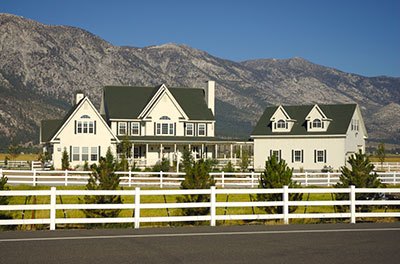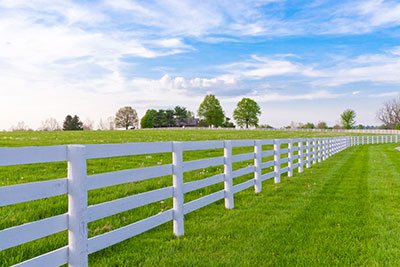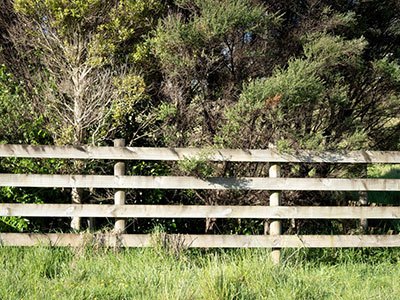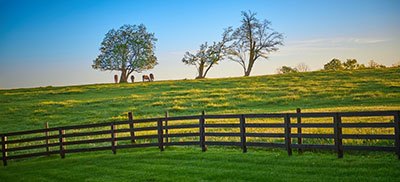Establishing and maintaining a safe, secure fence around your ranch is essential for keeping pests away from your land, animals safe, and property lines intact. With the right materials and designs in place, you can create a beautiful yet practical solution that suits all of your needs!
In this blog post, we’ll cover some of the best ways to build a ranch-style fence so you can pick the one that will work perfectly for your farm. From materials to design options, learn how to construct an optimal fencing system.
Take away key points:
- Ranch fencing adds a rustic charm to your farm, keeping your animals safe
- Check the local council’s planning requirements and your zoning department to ensure there are no legal actions against the fence
- Keep your post units leveled to the ground to ensure the best concrete support and fence stability
Table of Contents
- Building a ranch-style fence with wire: Best guide for all ranchers!
- What is a fence for ranch animals & what is its role?
- Advantages & disadvantages of ranch fencing systems
- How to install a ranch-style fence?
- Step 1: Choose the right location by measuring the area
- Step 2: Use a string to mark the place for the fence posts
- Step 3: Use post hole diggers to dig holes for fence posts
- Step 4: Place fence posts in their designated places
- Step 5: Attach rails to secure the posts and construction
- Step 6: Add a gate for an easy access
- Maintenance tips for ranch fences
- Ranch fences vs. other fences
- FAQs
- Summary
Building a ranch-style fence with wire: Best guide for all ranchers!
If you need to learn more about ranch-style fences for keeping your livestock safe, read our guide below. We will explain the wholesome procedure for your building project.
What is a fence for ranch animals & what is its role?

A ranch fence is a type of fencing that is typically used on farms and ranches. It is usually made from wood, vinyl, or metal and can be used for a variety of purposes such as keeping livestock in, providing privacy, and defining property boundaries.
Ranch fencing is often designed to be low maintenance and durable enough to withstand the elements. They also provide an attractive aesthetic to any property, adding value to the home or business. Ranch fencing is also great for keeping animals safe while allowing them to roam freely.
Advantages & disadvantages of ranch fencing systems
While ranch fencing has many advantages, there are also some disadvantages to consider before installing one.
Advantages of ranch fencing systems
– Durability: Ranch fence design is typically made of wood, metal, or vinyl, all of which can withstand the elements and last for many years with minimal maintenance.
– Cost-effective: Compared to other types of fencing materials, a ranch conventional fence tends to be more affordable and cost-effective in the long run.
– Versatile: Ranch fencing comes in various styles and sizes, making them suitable for any property size or type. Additionally, they can be customized with different colors and designs to fit your aesthetic needs.
– Security: A ranch fence provides an extra layer of security by keeping unwanted visitors out while providing a safe environment for pets and livestock inside the property line.
Disadvantages of ranch fencing systems
– Visibility: Depending on the style chosen, ranch fencing may not provide much privacy from neighbors or passersby due to its open design structure.
– Maintenance: Wood and metal ranch as a more restrictive fencing requires regular maintenance such as painting or staining every few years to prevent weather damage and rot over time. Vinyl fencing is more durable but still requires occasional cleaning with soap and water to maintain its appearance.
– Installation: Installing a ranch fence can be labor intensive depending on the size of your property and the type of material used. It’s best left to professionals if you don’t have experience with home improvement projects like this one.
How to install a ranch-style fence?

Installing a ranch-style fence is a great way to add privacy and security to your property. The steps for installation are fairly straightforward, but it’s important to take the time to do it right. Here’s how:
Step 1: Choose the right location by measuring the area
Start by measuring the area you want to fence off and then mark out the perimeter with stakes. Make sure that the stakes are spaced evenly and that they’re at least 6 inches (15 cm) above ground level.
You can also extend your measuring tape from one of the stakes marking an end post or the nearest corner of your fence post. You will extend the string to the nearest stake marking an end post or a corner post of your fencing.
Step 2: Use a string to mark the place for the fence posts
Tie Mason string between the stakes so it’s 6 in (15 cm) high. This will help you keep track of where each post should go as you install them.
You can check the exact distance between the first post, second post, and end posts by measuring tape and checking if you need to add a wooden stake in between to keep your fence optimal. The same method can be applied to the first and second holes later when digging.
Step 3: Use post hole diggers to dig holes for fence posts
Dig holes for each post with a post-hole digger. Ensure the post holes are deep enough that they won’t move around when pressure is applied to them. The depth of the post hole should be equal to one-third of the height of the post plus 6 inches (15 cm).
Ensure you keep the tops of the posts at the same eye level plane, and ensure you dig post holes for all posts at the same depth with your post-hole digger or auger.
If your post holes are not of the same depth, your planks’ angle and post level will not be of the same height, so inaccurate measurements lead to unstable posts.
For instance, the third hole should be aligned with the first two drill bit units. If it’s not, your rail fence won’t be level for optimal use. Also, pay attention to the T-posts. T-posts will secure the proper fence line, so you must also place them correctly.
Step 4: Place fence posts in their designated places
Place the first post in its hole and fill it around it with dirt or concrete, depending on what type of soil you have in your area. Make sure that each post is level in its post holes before moving on to the next one. You’ll ensure the fence runs well secured and you can decide how many post holes and pilot holes you need.
Also, align the stakes for the stability of the fence. Place the first stake in the determined position. Then add the next stake, and new stakes to keep the construction stable. If your second stake, for instance, is not equal to the first and the third one, ensure you keep the measuring tape horizontal to fix the issue.
Step 5: Attach rails to secure the posts and construction
Once all of your posts are in place, attach additional rail boards between them using galvanized nails or screws, depending on what type of material you’re using for your rail fence (wood, vinyl, etc.).
You might need a few tools or more depending on the size of your rail fence. You will also know how many rails or how many materials from a local hardware store you need for the level plane rail fence.
Make sure that the bottom rail board is level before attaching it to the posts and adding the next rail board so that your rail fence looks even when finished.
Step 6: Add a gate for an easy access
Finally, attach the first board or slat along the top rail if desired for extra privacy or aesthetic purposes. You can also add a gate if needed to your rail fence for easy access into and out of your yard or property area.
Maintenance tips for ranch fences

Maintaining a ranch fence is an important part of keeping your property safe and secure. Here are some tips to help you keep your ranch fence in top condition:
– Clean your fence every 2-3 years: Dirt and debris can easily accumulate on wooden fences, especially in rural areas. Regularly cleaning your fence with a pressure washer or brush will help keep it looking its best.
– Check wire tighteners twice a year: If wire tighteners are used on the fence, make sure to check them at least twice a year for any broken wires that need splicing.
– Stain or paint the fence: Staining or painting your wood fence will help protect it from the elements and extend its life span. Make sure to re-stain it every 3-5 years for optimal protection.
– Trim trees and clip bushes: Keeping vegetation away from the fence is essential for maintaining its integrity and preventing damage from animals or insects.
– Remove piles of leaves: Leaves can cause rot in wooden fences if they are not removed regularly, so make sure to clear them away before they have a chance to build up around the base of the fence posts.
Ranch fences vs. other fences
Ranch fences are a great option for those looking to fence their property. They offer a unique look that is both attractive and functional. Compared to other types of fencing, ranch fences provide more security and privacy than most other options. Additionally, they are often more affordable than other types of fencing, making them an ideal choice for many homeowners.
Ranch fences are typically made from wood or metal, with the latter being the most popular choice due to its durability and long lifespan. Wood ranch fences can be stained or painted to match the home’s exterior, while metal ranch fences come in a variety of colors and styles. Both materials offer good protection against animals and intruders, making them an excellent choice for rural properties.
When compared to chain link fencing, ranch fences provide more privacy and security as well as a more aesthetically pleasing look. Vinyl fencing is also a popular option for those looking for a low-maintenance fence that won’t require much upkeep over time. However, vinyl fencing does not offer the same level of security as wood or metal ranch fencing does.
FAQs
What type of fence goes with a ranch-style house?
The best combination is a low chain link fence in the front and a high wooden privacy fence in the back.
What is the spacing for ranch-style fence posts?
The standard spacing of fence post units should be between 8 and 25 feet apart.
What is the least expensive ranch fencing?
The cheapest version for outdoor use is barbed wire fencing.
What is the best wood for a ranch fence?

Cedar is a great option for ranch fencing as it is extremely durable and has the natural ability to ward off pests, including termites, which can harm wooden posts in the long run.
Cedar doesn’t require any treatment to maintain its durability, making it a more environmentally conscious choice.
Why are ranch-style homes more expensive?
Ranch homes are typically pricier than traditional houses because of the higher expenses involved in construction and the substantial size of the land on which they are built.
Summary
The ranch rail fencing requires post-hole diggers and similar tools for installation. But they provide weather-resistant screws and other parts to keep the system optimal. The hardest part is to keep it aligned, but you can use tapes for long edges and narrow ends, for maximum height and stability.
